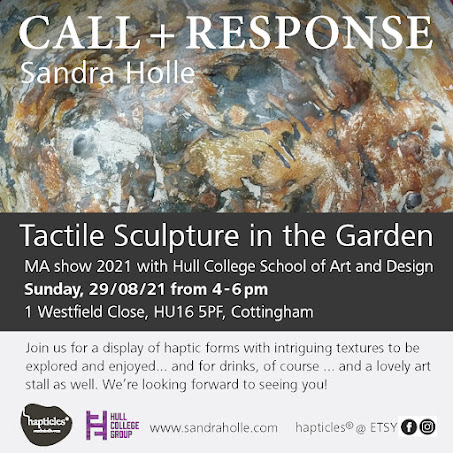A few words about the senses and touch in particular - and emotions
The more I am experimenting, researching and thinking about my subject matter, the more apparent my aim becomes. I want my objects to be tempting to touch. I think, the inclination to take something into our hands and explore its surface depends a lot on how appealing it looks. Vision and touch are senses that are connected, integrated. (see sensory integration) If it's 'umami' for the eyes, then we also want confirmation that it feels just as good as it looks. What happens when our vision is betrayed by an incongruous experience when touching the object. Are we disappointed because our expectations through what we saw aren't met through thouching the object? Are we surprised of what we find out when we touch the object? Are we bored, because the object feels exactly how we thought it would after looking at it? There might be a degree of personal preference involved here, as well.
Stellar, J. E. & John-Henderson, N., 2015. Positive Affect and Markers of Inflammation: Discrete Positive Emotions Predict Lower Levels of Inflammatory Cytokines. American Psychological Association, 15(2), pp. 129-133.
All in all, the interesting thing is, that there are now data available, which suggest that positive emotions have a positive effect on our wellbeing. (Stellar & John-Henderson, 2015) In my case, it would be the question of how effective stimulation through discriminative touch would be on, say, mental well-being, for example. We need positivity in our lives and that's not just a claim or slogan that a motivation coach might use.
We crave positive emotions like praise, gratitude or awe. According to Stellar's trial, where the effect of emotions like gratitude, praise or awe was examined, there is evidence that suggests that these help the body to reduce inflammatory agents called interleukin-6 (IL6). This effect appeared to be most significant when the participants experienced awe. (Stellar & John-Henderson, 2015)
Further, the findings of Dr. Lisa Feldman Barret, who has been researching the relationship between emotions and brain activity for about 20 years, tell us that we are making emotions out of our own accord and that there are no built in mechanisms that orchestrate and produce emotions in our brain. (Feldman Barret, L. 2018)
So, with the responsibility on us, what kind of emotions we live on and with, can we conclude, that we can do things that help our emotions to be more positive? I'd like to think that very much and these suggestions make me feel very hopeful and optimistic.
Let's subject ourselves to things that we know, that make us feel good or even let us be in awe.
Small customised objects or palm stones/worry stones are popular items to hold and fidget with as tools to modulate sensory input and are also established as fidget tools in occupational therapy. (Menillo, M., 2017) (Menillo, M., 2018) (Ashworth, H. 2019)
Qui gong balls in combination with specific movement patterns have long been a tool for meditation and focus in Asian culture.
Drawing and learning from this multitude of angles, I'd like to subject my audience to forms and surfaces that make them want to stop and look and explore and wonder.
I saw my chance for spreading the word about the beneficial tactile activity of intuitive clay modelling and showing my haptic work to the public when I heard about the cultural event that would take place in July. It would be organised by Absolutely Cultured Hull in support of local artists.
This is my application to the brief for a space during the event called Creative Hull:
Sources:
Mennillo, M., 2017. https://occupationaltherapychildren.com.au. [Online]
Available at: https://occupationaltherapychildren.com.au/sensory-integration-back-to-basics/
Mennillo, M., 2018. Modulation_ we all do it, but how well_! - OTFC.pdf. [Online]
Available at: https://occupationaltherapychildren.com.au/modulation-we-all-do-it-but-how-well/
Hannah Ashworth, Why do we fidget? - BBC Science Focus Magazine
https://www.sciencefocus.com/the-human-body/why-do-we-fidget/
Linda Feldman Barret, 2018, How Emotions Are Made: The Secret Life of the Brain


Comments
Post a Comment